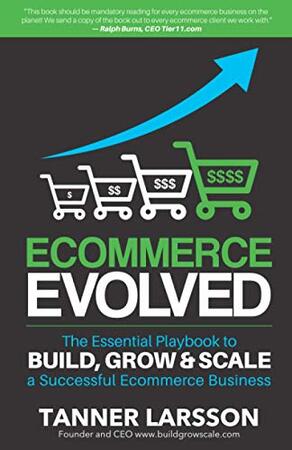Table of Contents
Create an ecommerce website and take advantage of its remarkable opportunities. Firstly, it enables you to reach numerous clients globally. This allows your business to expand its customer base beyond existing geographic boundaries. Online stores allow entrepreneurs to reach a huge market and target consumers worldwide. Running an ecommerce business also eliminates the need for a physical storefront, reducing the cost of rent, infrastructure and labor. With the right strategies individuals can benefit from this and generate income thorough selling online, dropshipping, affiliate marketing or marketing their brand and products.
The ecommerce industry in the United States has grown exponentially in recent years, with an estimated $768 billion in revenue last year. According to Statista, experts project this number to top $1.3 trillion over the next three years. As a retailer, setting up an ecommerce website gives you a lucrative opportunity to stake your share in this growing market. In this comprehensive guide, we’ll walk through eight easy steps to help you create an ecommerce website which is profitable.
Find a Content Management System (CMS) to use
Selecting the appropriate content management system is crucial in order to create an ecommerce website. Numerous ecommerce solutions exist online. While each of them excels in its own way, it all depends on your budget, levels of experience and specific ecommerce needs. Some of the best known ecommerce platforms include:
- WordPress: A highly customizable platform that is widely regarded as the industry leader.
- Shopify: An excellent ecommerce solution specifically targeted at dropshipping.
- Squarespace: Suitable for beginners seeking a user-friendly website builder to create professional websites without any prior web design background.
- Square Online: Particularly suitable for established retailers aiming to sell their products both online and in-person.
- Wix: An all-in-one website builder known for its user-friendly interface and a broad range of customization options.
- Magento: Huge range of features for building scalable and personalized ecommerce websites.
- HubSpot: Comprehensive suite of ecommerce, marketing, sales and customer service tool all in one place.
To assist you in choosing a suitable ecommerce CMS, keep in mind the following factors:
User Friendliness
An ideal CMS should be user-friendly, making it easy for average users to create an online store. It should provide a clear understanding of its functionalities, allowing you to handle product listings, upload images and edit product information.
SEO Optimization
A good ecommerce CMS should aid in optimizing your content for on-page SEO and implementing best practices. It should enable you to organize your page URLs, helping you create pages that are concise, readable and understandable. This is what search engines usually like and increases your website Google value ranking. Furthermore, the CMS should prompt you to add meta descriptions, which increases click-through rates by providing a preview of your page’s content on search engines. The ability to format page titles and H1 tags easily is also necessary for SEO and user navigation. Take note that the CMS should offer customization options for URL structures, allowing you to incorporate target keywords and improve overall clarity.
Customizable User Experience
Your ecommerce website should reflect your business values and offer a seamless user experience. Look for an ecommerce CMS that enables high customization and design options for every aspect of your online store. This includes the appearance of product listings and the behavior of the cart when users add items. Moreover, the CMS should allow you to update your online store’s design to align with trends, special occasions, store promotions and other marketing initiatives.
Integrations
While most platforms provide essential features for selling online, you may want to integrate other third-party tools and plugins to enhance user experience. Therefore, it is important to choose a CMS that easily integrates with these external tools and plugins, providing flexibility for customization. This ensures that you can fully tailor your ecommerce website to suit your target audience’s preferences and build a unique online experience.
By taking into account the mentioned factors, you can select an ecommerce CMS that aligns with your requirements, simplifies the creation of your online store, optimizes SEO efforts, provides a customizable user experience and is flexible.
Create an Account or Get Web Hosting
After deciding on a CMS, the next step involves either creating an account or obtaining web hosting services, depending on your chosen platform.
Platforms like Shopify, Squarespace, Square Online or Wix simplify the process by allowing you to register for an account directly on their websites. Some CMS options even provide the convenience of domain registration within the platform itself, eliminating the need for manual configuration.
If you opt for WordPress, you’ll need to secure a web hosting plan that offers a free domain name, SSL certificate and easy WordPress installation. The following is a more detailed look into what you need from your hosting service.
Type of hosting
The top hosting services typically offer everything you need to run a quality website. The options you’ll usually encounter are shared hosting, VPS hosting, cloud hosting and dedicated hosting. For beginners, shared hosting is recommended as it provides the necessary resources and is easy to manage. Once your business grows you can switch to VPS or cloud hosting which are relatively similar. They are also relatively easy to manage and are much more powerful. As your website grows even bigger, you can upgrade to dedicated hosting. However running a dedicated server requires technical and server management knowledge. Running on a dedicated server is usually not required until you are several years into your business and have thousands of customers.
Storage & bandwidth
Storage and bandwidth are important things to consider. Look for hosting services that offer unlimited storage and bandwidth, although on shared hosting, it may not be truly unlimited due to resource sharing. If your website traffic increases significantly, you might need to switch to VPS or cloud hosting.
Domain
The number of domains allowed is another factor to remember. Some hosting services restrict the number of domains you can have while others offer unlimited domains and subdomains. Having the flexibility to add extra domains is beneficial for expanding your online presence.
Security
Having an SSL certificate (HTTPS) is critical for website security and user trust. Most hosting services provide free SSL certificates for the primary domain, which helps improve your website’s credibility and ranking on search engines like Google.
Select an Ecommerce Theme or Template
When you want to create an ecommerce website, the visual identity is an important part. Choose a theme or template that aligns with your brand image and resonates with your target audience. CMS platforms typically offer a wide range of prebuilt templates and themes to choose from. While free options are available, make sure you explore paid themes as they often provide more unique and customizable designs. There are various WordPress themes and Shopify themes which are popular and suited for ecommerce. This step plays a vital role in creating a captivating user experience. Following factors will help you to choose the best theme:
Responsive design
A clean and responsive design creates an attractive and user-friendly website. Ensure that the theme works well on mobile devices and allows visitors to easily read, navigate and interact with your website.
Number of products
Determine the number of products you plan to sell and choose a theme that suits your catalog size. If you have a single product type, you can showcase everything on the homepage, but if you have a larger catalog, opt for a theme that allows you to feature a selection on the homepage and provide a well-designed product page for the rest.
Loading time
If you are striving to create an ecommerce website which is userfriendly and attracts more users you need to have a fast website. Although the server bandwidth and speed define this, your theme also plays an important role. Fast loading time is essential to prevent customers from delays. Look for lightweight themes that won’t negatively impact your store’s speed. Avoid installing unnecessary plugins, as they can slow down your website.
Compatibility
Ensure compatibility with ecommerce plugins, as they allow you to add advanced features without coding. However, be aware of compatibility issues, especially with third-party plugins, depending on your ecommerce platform.
To stand out from competitors, avoid using themes that make your store look identical to others in your industry. Look for customization options that align with your specific needs, such as page builder options, translation readiness and add-ons.
Before building your online store check out the capabilities and limitations of the chosen theme to ensure it meets your requirements and supports your desired user experience.
Customize Your Site and Build Web Pages
Customization is key to giving your ecommerce website a personalized look that reflects your brand identity. Utilize the available tools to modify parts such as the header, footer, navigation and other visual components. Building essential web pages like the homepage, About us, product pages, refunds and return policy page ensures consistency and helps users navigate your site effortlessly.
Create Compelling Product Listings
Engaging and informative product listings are fundamental to driving sales on your ecommerce store. Invest time in creating compelling product descriptions that highlight the features, benefits and uniqueness of each item. Each product should go through a product launch phase to get the maximum sales. Organize your listings into relevant categories, enabling customers to easily find what they’re looking for. Effective product presentation and organization enhance the overall shopping experience.
When writing product descriptions, it’s important to focus on your ideal buyer and use language that addresses them directly. Consider their preferences, use their words and create a conversation-like tone. Emphasize the advantages of your product to overcome cognitive bias and highlight how it solves your customers’ pain points.
Avoid using generic phrases and be specific in your descriptions to increase credibility. Justify any superlatives by providing proof or customer testimonials. Appeal to your readers’ imagination by allowing them to envision owning and using your product.
Incorporate mini-stories to get over rational barriers and make the descriptions more engaging. Use sensory words to create a pleasant feeling for your readers and leverage social proof by including customer reviews and ratings. Make your descriptions easily scannable by using headlines, bullet points and ample white space.
Lastly, set goals and key performance indicators (KPIs) to track the effectiveness of your product descriptions and make improvements based on the data.
Set Up a Payment Gateway
Payment gateways play a significant role in ecommerce by securely processing online payments and facilitating the transfer of funds between customers and businesses. They provide a secure and convenient way for businesses to authorize and process credit card transactions, protecting against fraud and financial risks. By using a trusted payment gateway, businesses can instill customer trust and protect sensitive financial information. Payment gateways may charge fees for their services, typically based on a percentage of the transaction or a flat fee per transaction.
Streamline your customers’ purchasing process by integrating a secure and user-friendly payment gateway. Many online retailers opt for third-party tools like Stripe or PayPal to simplify payment processing while ensuring data security. Remember that Integrating shipping options will provide a better user experience. Determine your shipping policies, such as free shipping, variable fees or flat rates and establish clear refund and return policies. If necessary, incorporate a tax calculator so you can automatically calculate sales tax, shipping costs and additional fees during the checkout process. Some of the best know payment gateways suitable for ecommerce include Stripe, PayPal, Planet, Fondy, Square, 2CheckOut and Authorize.net.
Setup inventory
You should look into inventory even before you start to create an ecommerce website. Effective ecommerce inventory management is essential for running a successful online business. Here are some key tips:
- Research your product demand: Analyze trends and use tools like Google Trends and Google Analytics to gain insights into customer demand for your product category. This will help you determine when to order more or less inventory.
- Forecast future demand: Use past data and trends to predict future demand. Consider seasonality and special events when planning inventory orders. Tools like Google Trends and Google Analytics can provide valuable insights for forecasting.
- Have safety stock: Prepare for unforeseen circumstances by maintaining safety stock. This extra inventory will help you stay afloat during unexpected events like panic buying. Balance having enough safety stock without overcrowding your warehouse.
- Set a minimum viable stock: Establish minimum stock levels to avoid supply chain disruptions and fulfillment delays. Determine the lowest inventory level needed to meet demand and reorder from your manufacturer when quantities fall below that threshold.
- Ensure proper storage: Having excess inventory is beneficial, but it requires efficient storage. Implement a system to locate and account for items easily. Consider using ecommerce inventory management software if it fits within your budget.
By following these inventory management tips, you can optimize your inventory levels, meet customer demand and enhance your overall ecommerce operations. Remember that you have to take note of everything and use a product numbering system like SKU to track your products.
Test and Launch Your Ecommerce Site
Before unveiling your ecommerce website to the public, test its functionality and usability throughly. Make sure that all buttons, links and forms are functioning correctly. Test the shopping cart and payment process, using test payment methods to confirm smooth transactions. Verify that corresponding emails are being sent upon successful purchases or declined transactions. Lastly, assess the website’s performance across various devices and browsers to guarantee optimal user experience. Once you have conducted thorough testing and addressed any issues, you are ready to launch your ecommerce website.
Further reading
The following book is a best seller which gives you a deep insight into the field. In this very intriguing book titled “Ecommerce Evolved,” Tanner Larsson discusses a detailed blueprint meticulously crafted for both entrepreneurs and business owners who want to excel in ecommerce. With a laser focus on constructing, expanding and propelling a lucrative online enterprise.
Conclusion
Create an ecommerce website and open up opportunities to tap into the growing online marketplace. Follow these eight steps and you can build a successful online ecommerce website, keeping up with the evolving customer demand and driving sales. Take advantage of the benefits that ecommerce offers and start building your ecommerce website today. Remember that continuous learning, testing, and optimization will be essential to enhance the performance and long-term success of your ecommerce website.






